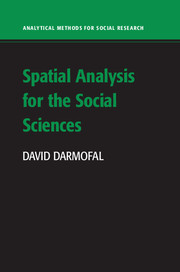9 - Advanced Spatial Models
from PART II - ADVANCED TOPICS
Published online by Cambridge University Press: 05 November 2015
Summary
Thus far, this book has examined models that are appropriate when the phenomenon of interest is measured as a continuous dependent variable. Often, however, social scientists are interested in explaining phenomena that do not lend themselves to linear models for continuous dependent variables. Spatial autocorrelation also affects phenomena typically studied through these more advanced models, such as limited dependent variable models, count models, or survival models. However, although spatial dependence is likely to be present in many of these more complex phenomena, it is rarely modeled even by applied researchers employing these advanced modeling strategies. Instead, for example, event counts at one location are often assumed to be spatially independent of counts at neighboring locations. Clearly, such an assumption is untenable. This chapter examines how social scientists can incorporate spatial dependence in more advanced modeling approaches beyond the linear model. It examines several types of advanced models familiar to applied researchers in the social sciences: binary dependent variable models, multinomial models, ordinal models, count models, and survival models.
SPATIAL BINARY DEPENDENT VARIABLE MODELS
Many phenomena of interest to social scientists such as interstate conflict, marital status, recividism, and the like take the form of binary variables. As is well known, estimators for continuous dependent variables such as ordinary least squares (OLS) are not applicable for these dichotomous dependent variables. Estimators such as OLS suffer from heteroskedasticity and non-normality, assume incorrect functional form, and can produce nonsensical predictions when the dependent variable is binary (see, e.g., Long 1997, 38–40). As a consequence, scholars utilize maximum likelihood (ML) estimators such as probit or logit. However, although these estimators are widely applied in the social sciences, rarely do social scientists model spatial dependence in the binary dependent variables of interest to them. This is problematic given the propensity of social science data toward spatial dependence. Interestingly, while spatial binary dependent variable models have been largely absent in the social science literature, these models represent a critical area of interest among current spatial analysis scholars, with many new estimators being developed in the past two decades. In this section, I examine these advances in modeling spatial dependence in dichotomous dependent variables.
- Type
- Chapter
- Information
- Spatial Analysis for the Social Sciences , pp. 158 - 199Publisher: Cambridge University PressPrint publication year: 2015

